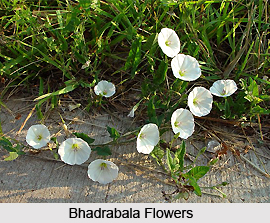Bhadrabala is the Sanskrit name of Bindweed. This plant is botanically cited as Convolvulus arvensis L. This plant is commonly named as `Gondal` in Bengali, `Nari` in Gujarati, `Beri` in Hindi, `Narangi balli` in Kannada, `Hiranpag` in Marathi and `Harinpadi` in Punjabi.
 Bhadrabala is a common plant with a wide pantropical and subtropical distribution. In India it occurs as a weed in cultivated areas throughout the country to an elevation of about 3000 metre in the Himalayas.
Bhadrabala is a common plant with a wide pantropical and subtropical distribution. In India it occurs as a weed in cultivated areas throughout the country to an elevation of about 3000 metre in the Himalayas.
Bhadrabala is a trailing or twining herb with a creeping rootstock. Leaves are alternate, 2.5cm to 6.5cm long, variable in breadth, ovate or oblong, usually glabrous, obtuse or apiculate at apex, auriculate or hastate at the base, lower leaves often lobed. The petioles are 0.6cm to 2 cm long. Flowers are white or pink, axillary and solitary. The peduncles are 2.5cm to 5cm long, slender with a pair of small linear bracts at the apex from which the pedicels arise. The pedicels are 3mm to 25mm long. The sepals are 5mm to 6mm long, broadly elliptic, obtuse or truncate, unequal and glabrous. The corolla is up to 2 cm long. Fruits are 6mm to 8mm in diameter, globose and glabrous. The seeds are subtrigonous, dark reddish brown in colour, glabrous or puberulous. The Bhadrabala plant bears flowers and fruits between December and March in central Indian deciduous forest regions. The roots of Bhadrabala are also used as a purgative.
This article is a stub. You can enrich the article by adding more information to it. Send your write up at www.content@indianetzone.com



















